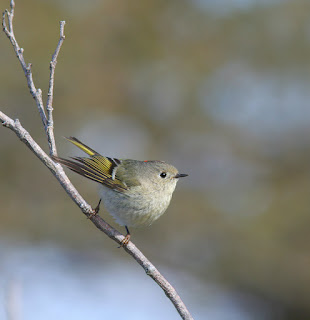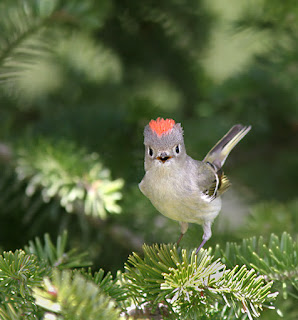I remember the first time I heard a Ruby-crowned Kinglet
singing. I thought what the heck is that! I search and searched looking for what could be singing so vociferously. Then when my binoculars fell on a Ruby-crowned Kinglet I could hardly believe it. How could such a loud, long song, come from such a small bird!
Sine that time Ruby-crowned Kinglets have been the bane of my birding efforts on more than one occasion. I remember doing bird surveys and straining to hear distant warblers, when all of a sudden a Ruby-crowned Kinglet starts wailing away from the tree tops. These birds have attitude to spare!
However, if they aren't singing Ruby-crowns (RCKI) can be somewhat difficult to see and they don't always show that nice Ruby crown.
 |
Ruby-crowned Kinglet- The ruby crown is barely visible in this photo
and is often not visible in the field |
What is always visible is a bold eye ring, a wing bar and those yellow/gold edges to the flight feathers. As well, RCKI's constantly seem agitated and flick their wings nervously as they move about. This is something most warbler species, do not do (Ruby-crowns aren't warblers of course, but are often with them in mixed flocks). As well, it's worth noting their call note at this time, since they only sing during the breeding season, the rest of the year their scratchy
call note is all you'll hear.
Ruby-crowns are one of the first arriving songbirds in Newfoundland often arriving in late April or early May, when it is still quite cold. Interestingly, they leave quite early as well, since their numbers thin out significantly into August and they can be hard to find in September.
 |
| Ruby-crowned Kinglet showing off it's ruby crown |
While they are in Newfoundland they do some amazing things, including lay a truly massive clutch of eggs. Ruby-crowns can lay up to 12 eggs and while each egg weighs on 1/15 of an ounce, the combined weight of the clutch can weigh the same as an adult Ruby-crowned!While you would think that all that singing and egg laying would burn a tremendous amount of energy, these frenetic birds are incredibly energy efficient and metabolic studies of Ruby-crowns have found that they can burn up to as little as 10 calories a day!
I'll leave you with a couple more photos of these little gems. See what I did there...gems...the bird's name is Ruby-crowned Kinglet...Ok, enough of that! Stay tuned for upcoming posts that will include more species profiles, quiz birds, ID features and much much more!
 |
| A red mohawk any punk rocker would be jealous of! |
 |
| Notice me! |









No comments:
Post a Comment